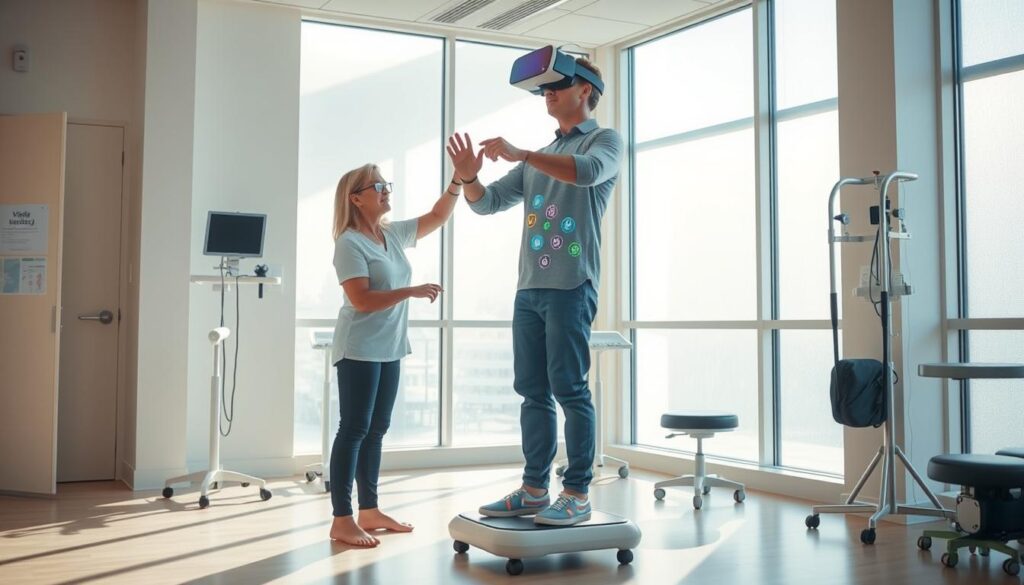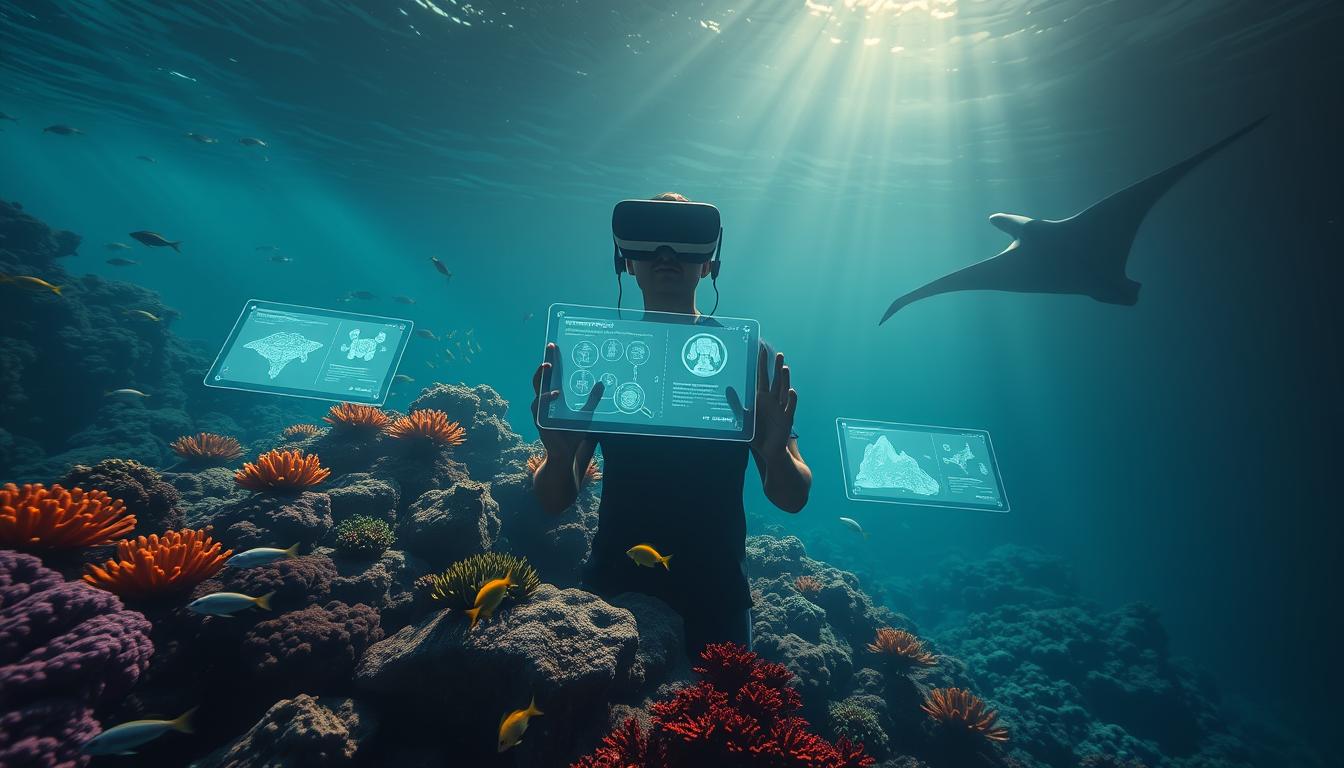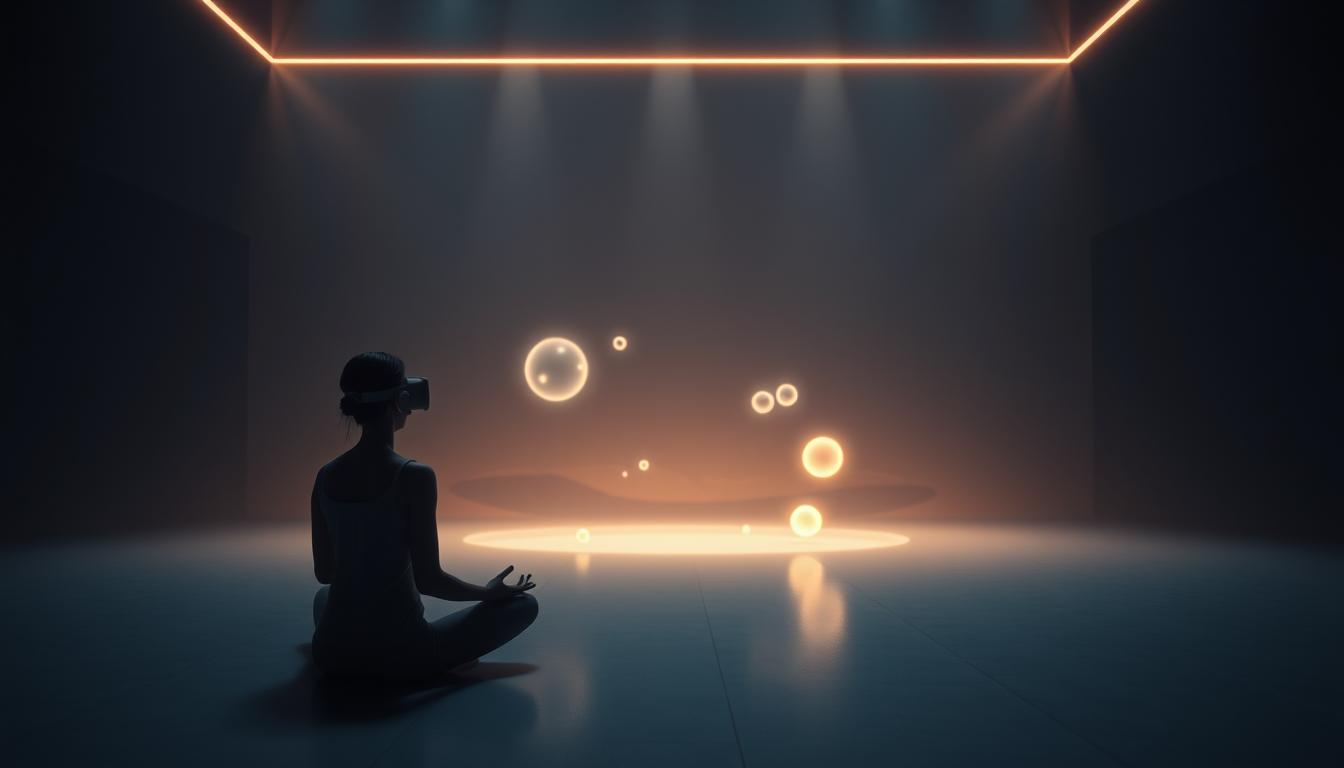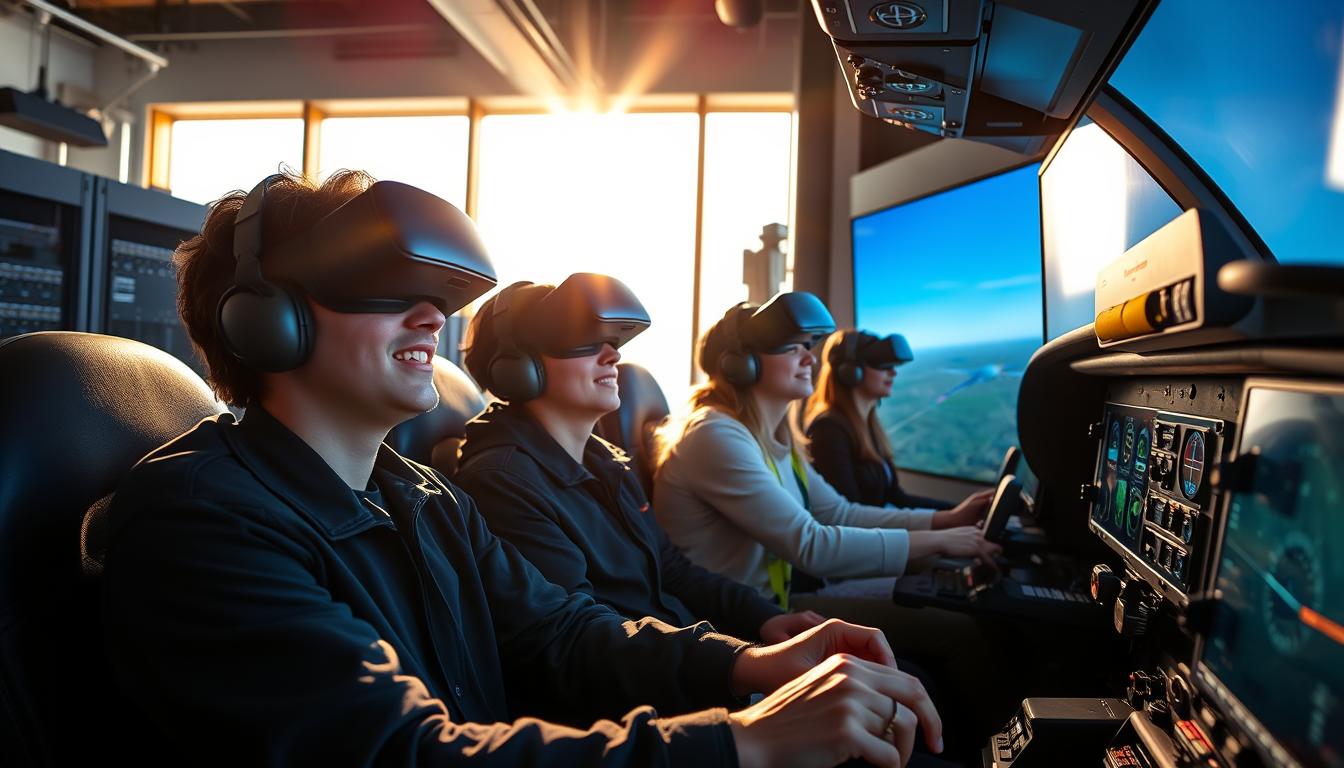Can virtual reality really change physical therapy for those with balance issues? This question makes us think about old ways of rehab and the new tech in healthcare. VR games for balance therapy are now being used as new tools for patients needing help with direction and coordination.
In this article, we’ll see how VR is changing therapy. It brings fun gaming to help improve therapy results for those with balance problems.
Introduction to Virtual Reality in Physical Therapy
Virtual reality in physical therapy is a game-changer in rehabilitation. It lets therapists create special experiences for patients. These experiences make therapy more fun and effective.
VR therapy plans can change as needed. It lets patients practice skills in a safe, virtual world. This way, they can work on balance and coordination better.
Using VR in therapy makes patients more involved in their recovery. It makes therapy feel more real and engaging. This leads to better results and a more positive experience for everyone.

Understanding Balance Disorders
Balance disorders are conditions that make it hard to stay steady and coordinated. They can come from many sources, like problems with the vestibular system, neurological issues, or musculoskeletal problems. Symptoms include dizziness, feeling unsteady, and trouble keeping a steady posture. These issues can really affect daily life and how well you feel.
The vestibular system is key to keeping balance. It’s made up of the inner ear and brain parts that handle motion and spatial info. When it doesn’t work right, it can cause serious balance problems. This is why finding the right treatment is so important.
Good treatment plans usually include exercises made just for the person. These might help with balance and keeping eyes steady. Knowing what balance disorders are and how they show up can really help in getting better. It makes the road to recovery more positive.

Benefits of VR in Rehabilitation
Virtual reality (VR) changes how we do rehabilitation. It offers benefits that go beyond old ways. One big plus is the personalized experience it gives. This lets patients dive into immersive therapy that feels real.
This therapy can make patients feel more, which helps them stay motivated. It helps them face challenges they might shy away from.
Another key benefit is the ability to control therapy levels. Therapists can change how hard the exercises are as they go. This makes sure the work is just right, not too easy or too hard.
This tailored approach leads to better results, especially for balance training. Here, the benefits of VR rehabilitation really show.
VR also lets patients practice in different settings. They can walk on uneven ground or move through crowded areas. This makes therapy more fun and helps them recover faster.
Studies say VR training can be better than old ways of rehab in some cases. Patients often get better at balance, coordination, and physical skills. The new and fun nature of rehabilitation technology advantages makes therapy more appealing and effective.
| Feature | Traditional Rehabilitation | VR Rehabilitation |
|---|---|---|
| Engagement Level | Lower | Higher |
| Customization | Limited | Dynamic |
| Motivation | Static | Interactive |
| Outcome Speed | Standard | Accelerated |
| Environmental Simulation | Minimal | Extensive |
How VR Games Enhance Vestibular Rehabilitation
VR games in vestibular rehabilitation offer new ways to help patients with balance issues. These immersive games create fun, engaging worlds that help improve how our bodies and brains work together. This leads to better results in therapy.
VR games make therapy fun by letting patients move in ways that feel real. This not only makes therapy enjoyable but also helps improve coordination. Players get to practice balancing and understanding space in a fun way.
VR games are made to tackle different parts of balance problems. They include activities that help with everyday skills. As players explore these virtual worlds, they improve their thinking and physical abilities without even realizing it.
VR games mix fun with function, making therapy more appealing. This mix of play and therapy can lead to better results. It keeps patients interested and motivated in their recovery.
Patient Profile: Doug’s Journey
Doug, a 58-year-old stroke survivor, is on a remarkable journey. He aims to regain his balance and motor functions. His daily struggles show the challenges he faces due to the stroke.
His healthcare team did a detailed assessment. They found areas needing attention. This led to a personalized recovery plan for him.
Doug’s Initial Assessment and Setup
Healthcare professionals evaluated Doug’s motor skills and balance during his initial assessment. This helped create a therapy plan tailored to his needs. The VR program used in his therapy includes immersive scenarios to improve his balance.
Using the Oculus Quest 2 in his sessions made therapy more engaging. It allowed Doug to focus on improving his movements without the usual pressure of traditional rehab.
Choosing the Right VR Program for Doug
Finding the right VR program was key for Doug’s recovery. The therapy team looked at several options. They chose one that would challenge his cognitive and physical abilities.
The chosen program allows Doug to gradually improve his skills. It gives him a platform to track his progress and stay motivated on his journey.
Top VR Games for Vestibular Balance Rehabilitation
Virtual reality has changed the game for rehabilitation, especially for balance issues. The right VR games can make therapy fun and focus on balance skills. Here are some top picks, each with unique features and benefits for balance therapy.
Game 1: MindMaze
MindMaze offers a deep dive into balance challenges. It creates virtual worlds that mimic real-life, helping users navigate and engage their balance systems. Its adjustable levels make it perfect for all skill levels, making it a top choice for therapy.
Game 2: Beat Saber
Beat Saber turns therapy into a fun rhythm game. Players cut through blocks to the beat, improving coordination and balance. The game’s music and visuals keep users motivated, proving the power of games in therapy.
Game 3: Reflexion Health VRStrokeRehab
Designed for stroke rehab, VRStrokeRehab offers exercises to boost balance and coordination. It tracks progress and adjusts the challenge, ensuring a personalized experience. Its adaptability makes it a favorite for improving vestibular health.
VR Therapy Sessions: Step-by-Step Overview
VR therapy sessions offer structured activities to help patients with balance disorders. They make sure patients are comfortable and engaged in meaningful exercises. These sessions include warm-up activities in a virtual world and specific therapy exercises in realistic settings.
Warm-Up Sessions in a Virtual Environment
Warm-up sessions are key to getting ready for physical activity. In a virtual world, patients move in immersive landscapes that help them stretch and be flexible. Activities like gentle stretching, balance exercises, and breathing techniques are common.
These activities help patients smoothly move into more challenging VR therapy sessions. They keep patients relaxed and ready for more.
Targeted Therapy Exercises in Realistic Settings
After warming up, targeted therapy exercises start. These exercises are tailored to each patient’s needs. They mimic real-life challenges to help patients recover functionally.
Activities include simulated walking, coordination tasks, and exercises that improve focus. This part of the session is crucial for building confidence and independence.
Engaging Patients Through Gamification
Gamification in therapy is changing how we see rehabilitation. It makes therapy fun and keeps patients motivated. By adding game elements to exercises, therapists can make therapy more exciting. This turns therapy into an interactive experience that patients look forward to.
This approach grabs attention and boosts motivation. Motivation is key to sticking with therapy. Using game elements like rewards and challenges helps patients stay on track. It makes them want to keep going, even when it’s tough.
There are big psychological benefits to this method. Patients feel proud and happy as they move up levels or get rewards. This feeling of success keeps them wanting to do more. Gamification helps with both physical and mental health, making therapy more effective.
| Gamification Element | Description | Effect on Patient Engagement |
|---|---|---|
| Points System | Patients earn points for completing exercises or achieving milestones. | Increases motivation and creates a sense of accomplishment. |
| Badges and Rewards | Awards given for reaching specific goals or demonstrating improvement. | Encourages patients to set and pursue goals. |
| Challenges | Timed tasks or competitive exercises that add a fun element to therapy. | Stimulates excitement and friendly competition among patients. |
| Storytelling | Narratives that incorporate the patient’s journey into a game format. | Makes the rehabilitation process relatable and engaging. |
Virtual Balance Drills and Coordination Exercises
Virtual balance drills offer fun and effective ways to boost coordination. They use VR technology for users to practice movements that test their balance. This not only keeps the body active but also sharpens the mind, which is key in recovery.
Virtual balance boards are a great tool. They make users balance while doing tasks. These tasks mimic real-life situations, helping patients train in a realistic way. The feedback from the virtual world and tracking of performance make it a powerful tool for healing.
Adding dynamic exercises to these drills can really help. For example, moving weight from one foot to another or turning in different directions. These actions are crucial for daily tasks and help prevent falls. They improve mobility and independence.
These VR programs are easy to use, letting users adjust exercises as they get better. This keeps the rehabilitation process exciting and challenging.
Feedback Mechanisms in VR Rehabilitation
Feedback in VR therapy is a game-changer for patient care. It lets therapists track how well patients are doing in real-time. This feedback is key for checking a patient’s skills and seeing if the therapy is working.
Therapists use this data to tweak treatment plans as needed. They look at things like how patients move, how fast they respond, and how engaged they are. This helps make sure the exercises are just right for each person.
In VR therapy, tracking performance helps set goals that are just right for each patient. Therapists keep detailed records to see how patients are improving over time. This helps improve therapy results and keeps patients motivated and involved.
Safe Use of VR for Patients with Dizziness
Using virtual reality (VR) in therapy for dizzy patients needs careful planning. It’s important to follow safety rules to make VR therapy better and more effective. Here are some key steps:
- Monitoring Patient Comfort: It’s vital to check how comfortable the patient feels while using VR. This helps avoid any discomfort, especially for those who get dizzy easily.
- Gradual Exposure: Starting slowly with VR can help patients get used to it. This way, they’re less likely to feel uncomfortable.
- Clear Instructions: Giving clear instructions and setting limits for movement helps keep the therapy safe.
- Appropriate Equipment: Using the right equipment can help patients who get dizzy stay stable during therapy.
- Emergency Protocols: Having clear emergency plans ensures a safe VR experience. It allows for quick action if the patient feels uncomfortable.
These steps help make a safe space for dizzy patients to get better. By focusing on safety, therapy can use VR’s benefits fully without risking the patient’s health.
Individualized Therapy Plans with VR Integration
Creating therapy plans that fit each person is key to good rehabilitation. Using virtual reality (VR) makes this even better. VR lets therapists tailor sessions to each patient’s needs and goals. This way, every activity is just right for the patient’s challenges.
VR helps therapists change the level of tasks on the fly. They can give patients feedback right away. This makes therapy more fun and effective. It can make environments feel real or adjust exercises for balance issues.
VR also helps track how patients are doing. Therapists can see how well patients are improving. This lets them change the therapy plan as needed. It makes patients feel like they’re really making progress.
Challenges and Limitations of VR in Physical Therapy
Virtual Reality (VR) in physical therapy has many benefits. But, we must face the challenges it brings. Not everyone can use VR because of lack of technology or space. This problem is worse in some areas, making it hard for some to get help.
Some patients might not feel comfortable with VR. They could get sick or feel uneasy. This makes it important to check how each person reacts to VR before starting therapy.
There are also tech issues to deal with. VR systems can be very expensive. Keeping them updated is another problem for clinics. This can make it hard to keep care consistent.
To overcome these problems, therapists need to focus on each patient. They should make VR experiences that fit each person’s needs and comfort. This way, VR can be more effective and enjoyable for everyone.
Future of VR in Physical Therapy
The future of VR in physical therapy is bright, thanks to quick tech advances. These changes make patient care and rehab better. VR is changing how we do therapy, making it more personal and effective.
VR tech is getting better fast. New tracking systems and realistic simulations help track patient progress better. This lets therapists give feedback that’s just right for each patient.
More people can use VR in therapy because it’s getting cheaper and easier to use. This means more folks can join in on therapy programs. It’s making therapy more open to everyone.
VR is also getting smarter with health-tracking tools. Wearable devices can send data right to therapists. This helps make therapy even more effective, leading to better results for patients.
Conclusion
VR in rehabilitation shows great promise for improving physical therapy results, especially for those with balance issues. It offers fun, interactive ways to learn balance and coordination skills safely. This makes therapy more engaging and effective.
Using VR in therapy has many advantages. It makes exercises more enjoyable and helps patients stick to their recovery plans. As VR technology gets better, we can expect even more exciting ways to help patients heal.
VR is changing physical therapy for the better. It’s important for therapists to keep up with new VR technologies. This way, they can offer the best treatments to those who need them.
FAQ
What are balance disorders?
Balance disorders make it hard for people to stay steady. They can feel dizzy or unsteady. This increases the chance of falling. Inner ear problems, brain issues, and muscle problems are common causes.
How does virtual reality help in rehabilitation for balance disorders?
Virtual reality (VR) makes rehab more fun and effective. It creates real-like environments for practice. This helps improve balance and coordination.
What specific benefits does VR offer compared to traditional therapy methods?
VR therapy has many advantages. It lets patients control the therapy pace and enjoy customized environments. It also makes therapy more engaging and provides instant feedback. This leads to better results.
Can you describe some VR games that are effective for vestibular rehabilitation?
Games like MindMaze, Beat Saber, and Reflexion Health VRStrokeRehab are great. They mix fun challenges with exercises to boost balance and coordination.
How are VR therapy sessions structured?
VR therapy starts with a warm-up. Then, it moves to exercises tailored for each patient. This approach helps improve balance while keeping patients interested.
How can gamification enhance patient motivation during therapy?
Gamification makes therapy more enjoyable. This leads to better adherence to exercises. It helps patients achieve better results.
What are some strategies for ensuring safety in VR therapy for patients with dizziness?
To ensure safety, use well-designed VR environments. Monitor patients closely. Provide easy exit options if needed. Adjust session intensity as required.
How can therapists customize VR rehabilitation plans for individual patients?
Therapists tailor VR plans by assessing patient needs and preferences. This ensures therapy meets specific goals and aids in recovery.
What are some limitations of using VR in physical therapy?
VR therapy faces challenges like accessibility and comfort with technology. Motion sickness is also a concern. Overcoming these issues is key to successful use in rehab.
What does the future hold for virtual reality in physical therapy?
The future of VR in physical therapy looks bright. Advances in tech and wider accessibility are expected. Integration with health tools will also boost its effectiveness.




